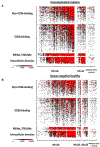Children with hemoglobin C or S trait have low serologic responses to a subset of malaria variant surface antigens
- PMID: 39216830
- PMCID: PMC11546587
- DOI: 10.1016/j.jinf.2024.106257
Children with hemoglobin C or S trait have low serologic responses to a subset of malaria variant surface antigens
Abstract
Children with hemoglobin AC or AS have decreased susceptibility to clinical malaria. Parasite variant surface antigen (VSA) presentation on the surface of infected erythrocytes is altered in erythrocytes with hemoglobin C (Hb AC) or sickle trait (Hb AS) mutations in vitro. The protective role of incomplete or altered VSA presentation against clinical malaria in individuals with Hb AC or AS is unclear. Using a high-throughput protein microarray, we sought to use serological responses to VSAs as a measure of host exposure to VSAs among Malian children with Hb AC, Hb AS, or wildtype hemoglobin (Hb AA). In uncomplicated malaria, when compared to Hb AA children, Hb AC children had significantly lower serological responses to extracellular Plasmodium falciparum erythrocyte membrane protein-1 (PfEMP1) domains but did not differ in responses to intracellular PfEMP1 domains and other VSAs, including members of the repetitive interspersed family (RIFIN) and subtelomeric variable open reading frame (STEVOR) family. Healthy children with Hb AC and Hb AS genotypes recognized fewer extracellular PfEMP1s compared to children with Hb AA, especially CD36-binding PfEMP1s. These reduced serologic responses may reflect reduced VSA presentation or lower parasite exposure in children with Hb AC or AS and provide insights into mechanisms of protection.
Keywords: Hemoglobin C; Hemoglobin S; Malaria; Mali; Plasmodium falciparum; Protein microarray.
Copyright © 2024 The Authors. Published by Elsevier Ltd.. All rights reserved.
Conflict of interest statement
Declaration of Competing Interest The authors declare that they have no known competing financial interests or personal relationships that could have appeared to influence the work reported in this paper.
Figures


References
-
- Agarwal A, Guindo A, Cissoko Y, et al. Hemoglobin C associated with protection from severe malaria in the Dogon of Mali, a West African population with a low prevalence of hemoglobin S. Blood. 2000;96(7):2358–2363. - PubMed
MeSH terms
Substances
Grants and funding
LinkOut - more resources
Full Text Sources
Research Materials

